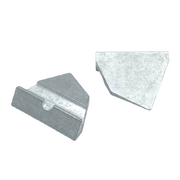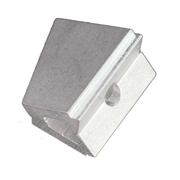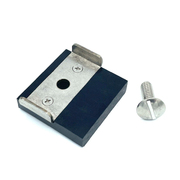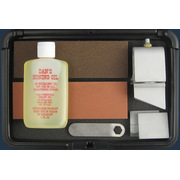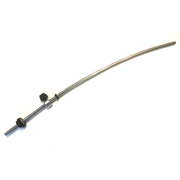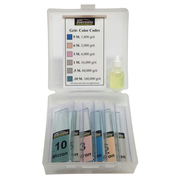Q. How can I tell for certain that I have the angle set correctly?
A. The easiest way to find the correct angle on any blade is to colour the factory bevel with a permanent marker, eyeball the angle as close as you can, then take a few swipes with a dry stone to see where the ink comes off. If the ink is gone from the cutting edge but not the shoulder of the bevel, that's telling you that the angle is set a bit too high. If the ink is removed from the shoulder of the bevel but not the cutting edge, that means the angle is set a bit too low. Adjust the angle up/down until the ink is being removed from the whole bevel and that will be the correct angle. It's better to error a little on the high side than on the low side. Once you know the correct angle setting to use for a particular blade or broadhead there's no need to colour the bevels anymore.
Note: The angle scales on all clamp type systems are relative. The distance a blade extends out in front of the clamp also influences the angle.
Q: Which are better, the diamond stones or the standard stones?
A: That depends on the particular job you’re doing. No one type is the best for all sharpening jobs.
Diamonds vs. Ceramic and Arkansas Stones:
These are basic guidelines for stone selection. There are many variables though, like exactly how dull is the blade? Do we need to remove a lot of stock to develop the bevels? How hard is the steel itself?
Diamond Stone Pros:
Diamond stones are far more aggressive than either ceramics or Arkansas stones. The coarser grit diamonds are great for rapid stock removal and for taking an edge from dead blunt to very sharp quickly. Diamonds are the best choice for sharpening blades made from very hard steels with Rockwell hardness above the mid 50s. A coarse or x-coarse diamond can be worth its weight in gold when sharpening/restoring severely damaged blades.
Diamonds are also a good choice for people who are new to sharpening and those who don't have a lot of time. This is because diamonds produce very good results quickly.
Diamond Stone Cons:
While diamond stones are great for speed sharpening, they’re not as good as fine ceramics or Arkansas for the final polishing needed to develop a true surgical edge. Diamonds are more expensive than either ceramic or Arkansas stones and contrary to popular belief they do wear out and will need to be replaced from time to time.
Note: While it’s never a good idea to push on any stone while sharpening in order to speed things up, this is particularly true with diamond stones. Diamond stones are manufactured by literally soldering diamond particles to a steel substrate (electroplating). Applying excessive pressure while sharpening will quickly destroy the stones by dislodging the particles. Use a light touch and let the stones do the work.
Arkansas Stone Pros:
Arkansas stones are polishing stones. A basic hard Arkansas is still one of the best polishing stones available. They are inexpensive and very long lasting. Very fine grit Arkansas stones like the black or translucent will polish blade bevels far beyond factory sharp.
Arkansas Stone Cons:
Arkansas stones are not intended for rapid stock removal but rather for polishing and refining an edge to surgically sharp. If you were to take a very dull blade and try to sharpen it using only an Arkansas stone you would spend hours trying to get the blade sharp but would likely only succeed in polishing the dull edge. You need to finish "grinding" or “profiling” the edge first with something more aggressive like a diamond stone or coarse ceramic.
Ceramic Stones:
They come in a wide variety of grits and can be made from various materials like silicon carbide (carberundum), or aluminium oxide (India and water stones), CBN (cubit boron nitride) or other abrasive materials.
The standard stones (ceramic and Arkansas) are our "go-to" stones for any blade that is even remotely sharp to begin with. The X-coarse silicon carbide is a very aggressive stock removal stone but it will wear quickly. Use this stone for quickly reprofiling the bevels on extremely dull blades. The coarse aluminium oxide ceramics are pretty aggressive and the fine side is reasonably fine. Diamonds stones, files, or automotive wet/dry sandpaper are better choices for fast stock removal, then go to the ceramics and finish with the Arkansas.
That's a quick run down but hopefully it shows that none of the above stones are "the best". It's more a question of which type of stone is the best choice for the job you're doing. It’s a good idea to have a variety of different stones so that sharpening will always be quick and easy.
Q. I just received the sharpener and I’m not getting results typical of your testimonials. The bevels appear uniformly polished but my knife isn’t nearly as sharp as I’d like it to be. What am I doing wrong?
A. Whenever we hear from a customer who’s not getting the desired level of sharpness, the cause is almost always the same: progressing through the grits too quickly. In other words, not spending enough time with the coarse stone(s). The actual cutting edge is formed at the coarsest stage of sharpening. It is critical to get your knife very sharp with the coarsest stone, and we do mean very sharp. It will be a coarse-feeling sharp, but very sharp none the less. In fact, the blade should be shaving hair or trying very hard to shave before going to the finer grit stones. If we leave the coarse stone prematurely (before the bevels intersect to create the cutting edge) then progressing though finer grit stones will only polish the bevels but won’t get the blade any sharper. Go back to the coarse stone and get the blade very sharp with that stone before advancing though the finer grit stones to refine and hone the blade.
The other possibility is that you could be pushing too hard on the stones while sharpening. Since sharpening is really grinding on some level, logic suggests that applying pressure will speed the process up a bit. That sounds good in theory but it doesn’t work in the real world. Use the full weight of your hand and arm but virtually no downward muscle exertion. By using light pressure and repetition rather than force you’ll see great improvement in your finished cutting edges.




